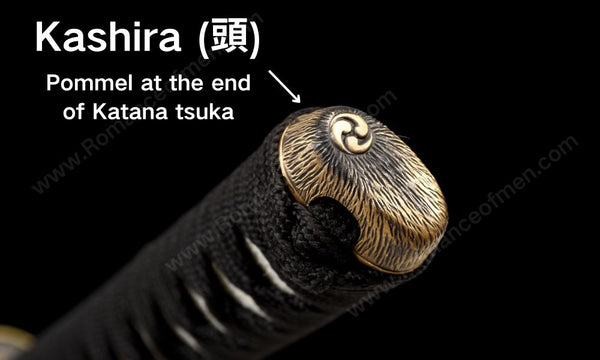Katana Kashira The little cap at the bottom of the Tsuka
All about Kashira
Each part of the Katana is essential and serves different purposes. Similarly, the Kashira, although small, is a crucial part of the sword. So, in this guide, I'll discuss everything you need to know about this component of the Japanese sword Katana.
Table of Content
- What Is Kashira 頭?
- Material of Kashira
- The History of Kashira
- The Common Types of Kashira
- Frequently Asked Questions about Kashira
What Is Kashira 頭?

The Kashira is the pommel of a katana. It is at the end of the katana handle (Tsuka), usually made of metal, in spherical shape with ornamental designs that match the theme of the fuchi. In Japanese Kashira is "頭", means "Head" in English.
The purpose of Kashira is to secure the tsuka, prevent Ito wrapping from getting loose, and maintaining the sword's balance. Craftsmen may create these from various materials, like ivory, metals, and wood, and frequently intricately ornament them. Kashira usually pairs with Fuchi as a set, Tsukaito starts from Fuchi, and ends in Kashira using a knot to tie them together.
While cutting and practicing, the Kashira may become loose and separate from the handle. However, it's not a severe issue. You only need to get a little glue and apply a small amount to the Kashira to stop it from moving.
Fuchi and Kashira

Fuchi "縁" and Kashira "頭" as a pair of Katana fitting (Koshirae), often called together as Fuchigashira "縁頭". The design of Fuchi and Kashira is usually matched as a pair, just like Tsuba and Menuki. They are one of the most noticeable features when a katana is worn at the waist. They showcase the craftsman's talent and sense of style through detailed carvings and inlays, making them fascinating to admire and reflect on the characters of those who ordered them. Many outstanding Fuchigashira design have been commissioned by influential individuals like daimyos and wealthy merchants, frequently distinguishing themselves as extraordinary works of art.
In Japan, the craftsmen for Kashira are Kinkōshi (金工師), they focus on the making of menuki, kozuka, kogai, fuchi and kashira. In Japanese sword traditional, when menuki, kozuka, and kogai—are made by the same artist and share similar designs, they are referred to as "Mitoshi-mono."三所物, means "three-place things". When these are paired with a matching set of Fuchi and Kashira, the set of five is called "Itsutokoro-mono" 五所物, means "five-place things".
Material of Kashira
The most common material for Kashira are metals, such as iron, copper, and brass, Horn is sometimes used, but it's rarely and mainly for decoration swords. In addition, there are leather kashira, which are covered in leather, and other kashira inserted with flint or magnets to enhance their decorative value.
The History of Kashira
The history of Kashira dates back to ancient Japan, we can find kashira with unique designs from swords such as 'Fern-Handled Swords' (Warabite-tō 蕨手刀) and 'Ryūgozuka Swords' (立鼓柄刀) in the Kofun period.
At the time when Tachi katana for ceremonial emerged, the mainstream Kashira were decorated with gold and silver, prioritizing aesthetics. But when Katana (either Tachi太刀 or Uchigatana打刀) became more and more practical in battle field, Kashira design shifted from ornamental to functional, using more sturdy metal and less decorative, to enhance durability and effectiveness in combat.
The Common Types of Kashira
When you wield the katana, when facing your enemy, kashira is the first thing they will notice. To show a samurai's majesty, many will meticulously decorate the kashira.
The decorations applied to the kashira and fuchi are varied, including plants and animals. For plants, 'millet', 'chrysanthemums', and 'arabesque patterns' are common.
In the case of animals, auspicious creatures like 'carp', 'dragonflies' (victory bugs), 'lions', 'cranes', and 'dragons' are often depicted alone, but it's also common for plants and animals to be depicted together on a single pommel or collar, the crest of the samurai who owns the sword are also commonly used in kashira.
- Higokago: This design possesses carved bamboo-style weaving.
- Amikago: It looks like a braided basket motif.
- Souryu: This design represents a spiritual legacy. Praying monks are the focus of the theme of it.
- Tonbo: It is a typical design for many Katana parts. It portrays a dragonfly.
- Ume: This design represents plum blossom.
In our custom katana section, Kashira and fuchi are pair with Tsuba.
Here are some traditional design fuchigashira, these are handmade from Japan:



Do not underestimate the importance of kashira and fuchi as part of the sword, as insignificant as they might seem. In ancient times, when a samurai wanted to purchase a katana, they would usually get a sword in plain wood mounting for storage (shirasaya), but such fittings just like the sword's pajamas, unfit for actual combat and doesn't look good.
Therefore, it was necessary to select desirable mounting such as the kashira and fuchi, Menuki, and Tsuba at the swordsmith's shop, then pay the sword fittings craftsman for a series of assembly work. During this process, the handle length and shape would be selected according to the school of swordsmanship or different uses, resulting in a weapon that not only has a dignified appearance, but is also suitable for actual combat.
Frequently Asked Questions about Kashira
What is Kashira made from in modern days?
Most manufacturers make Kashira from steel, brass, Iron, silver, or copper. However, the cheapest material for making this part is zinc alloy.
What are the common problems with Kashira?
The most common issue with the kashira is that it tends to become loose in time with use. But, it’s easily fixable with just a bit of glue.
What is a good Kashira
A good kashira should be durable, won't easily break after absorbing the shock from the katana tang (Nakago). in terms of kashira fitting, it should be align with the tsukaito like a straight line, so when you hold the bottom part, you won't feel uncomfortable,





















